Comprehensive Report: Business Environment Analysis for New Look
VerifiedAdded on 2021/01/01
|8
|2146
|425
Report
AI Summary
This report provides a comprehensive analysis of the business environment, focusing on different organizational types, purposes, legal structures, and the impact of micro and macro environments. The report examines private, public, and voluntary sectors, detailing their objectives, structures, and scopes, with examples like New Look and Asda. It further explores the relationship between various organizational functions such as HR, finance, operations, and marketing, and how they contribute to achieving business objectives. The report also delves into the size and scope of organizations, providing insights into how market forces and economic activities influence business operations. The report concludes by emphasizing the interconnectedness of internal and external components in shaping organizational outcomes. It provides a detailed overview of the business environment and its implications for companies like New Look.
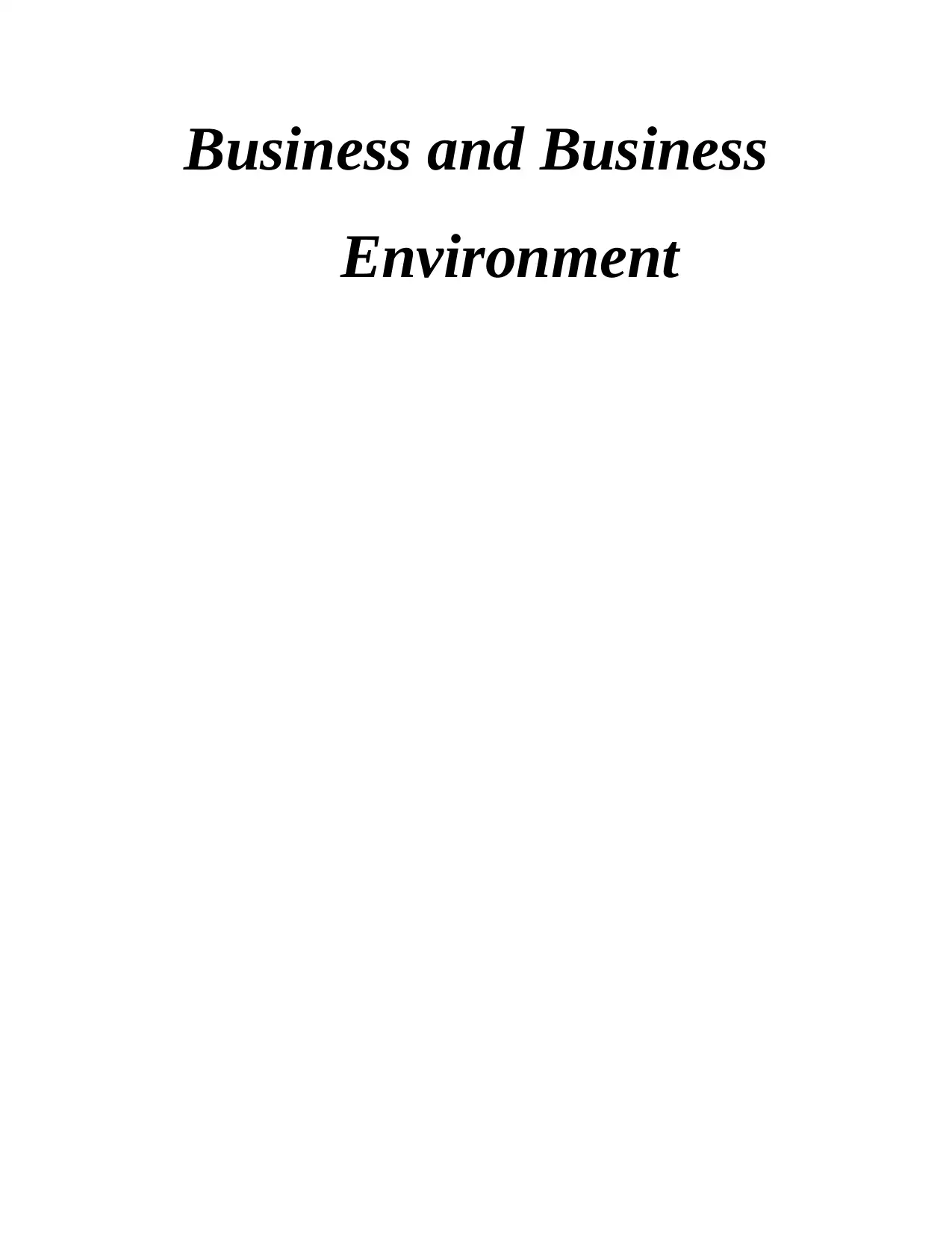
Business and Business
Environment
Environment
Paraphrase This Document
Need a fresh take? Get an instant paraphrase of this document with our AI Paraphraser
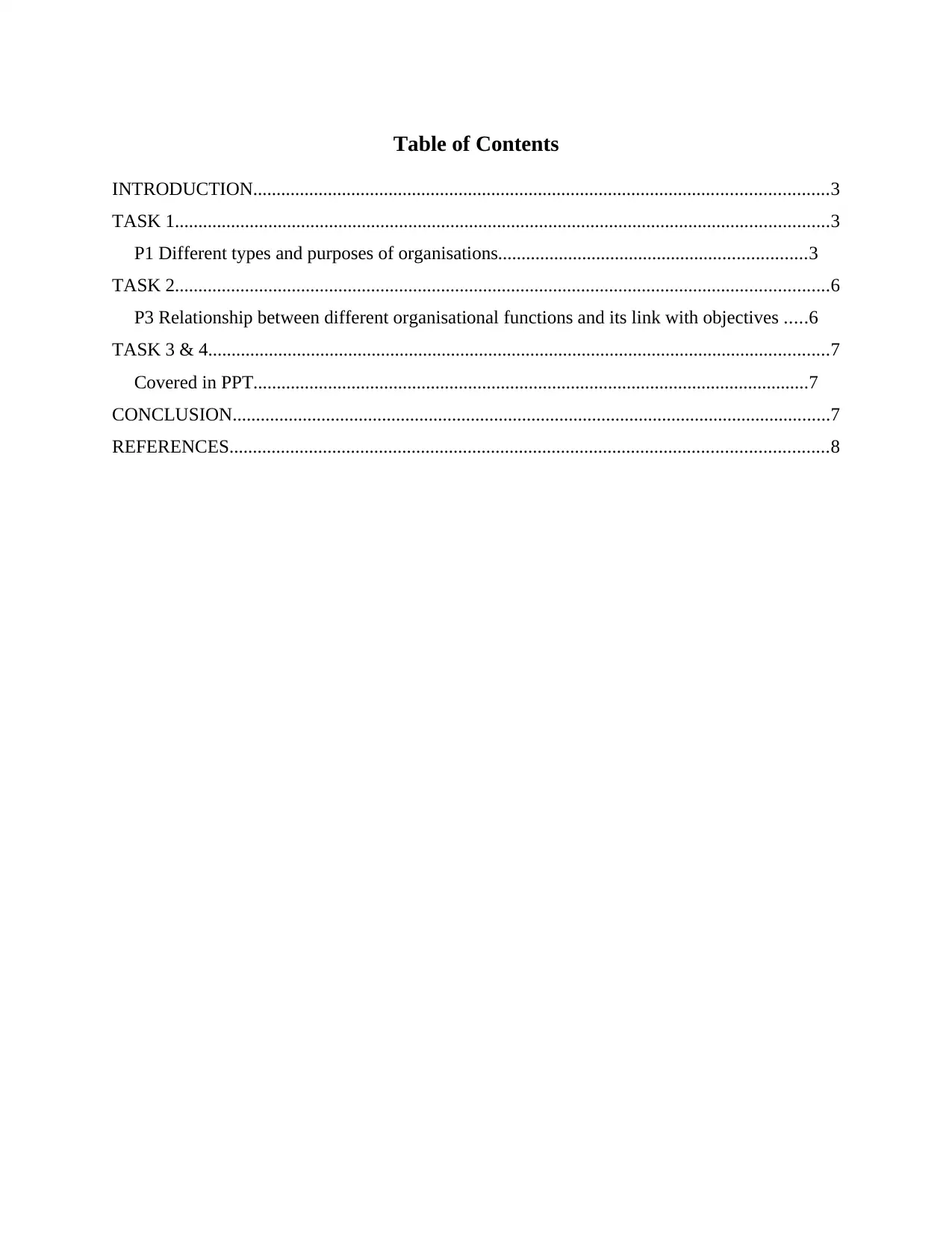
Table of Contents
INTRODUCTION...........................................................................................................................3
TASK 1............................................................................................................................................3
P1 Different types and purposes of organisations..................................................................3
TASK 2............................................................................................................................................6
P3 Relationship between different organisational functions and its link with objectives .....6
TASK 3 & 4.....................................................................................................................................7
Covered in PPT.......................................................................................................................7
CONCLUSION................................................................................................................................7
REFERENCES................................................................................................................................8
INTRODUCTION...........................................................................................................................3
TASK 1............................................................................................................................................3
P1 Different types and purposes of organisations..................................................................3
TASK 2............................................................................................................................................6
P3 Relationship between different organisational functions and its link with objectives .....6
TASK 3 & 4.....................................................................................................................................7
Covered in PPT.......................................................................................................................7
CONCLUSION................................................................................................................................7
REFERENCES................................................................................................................................8
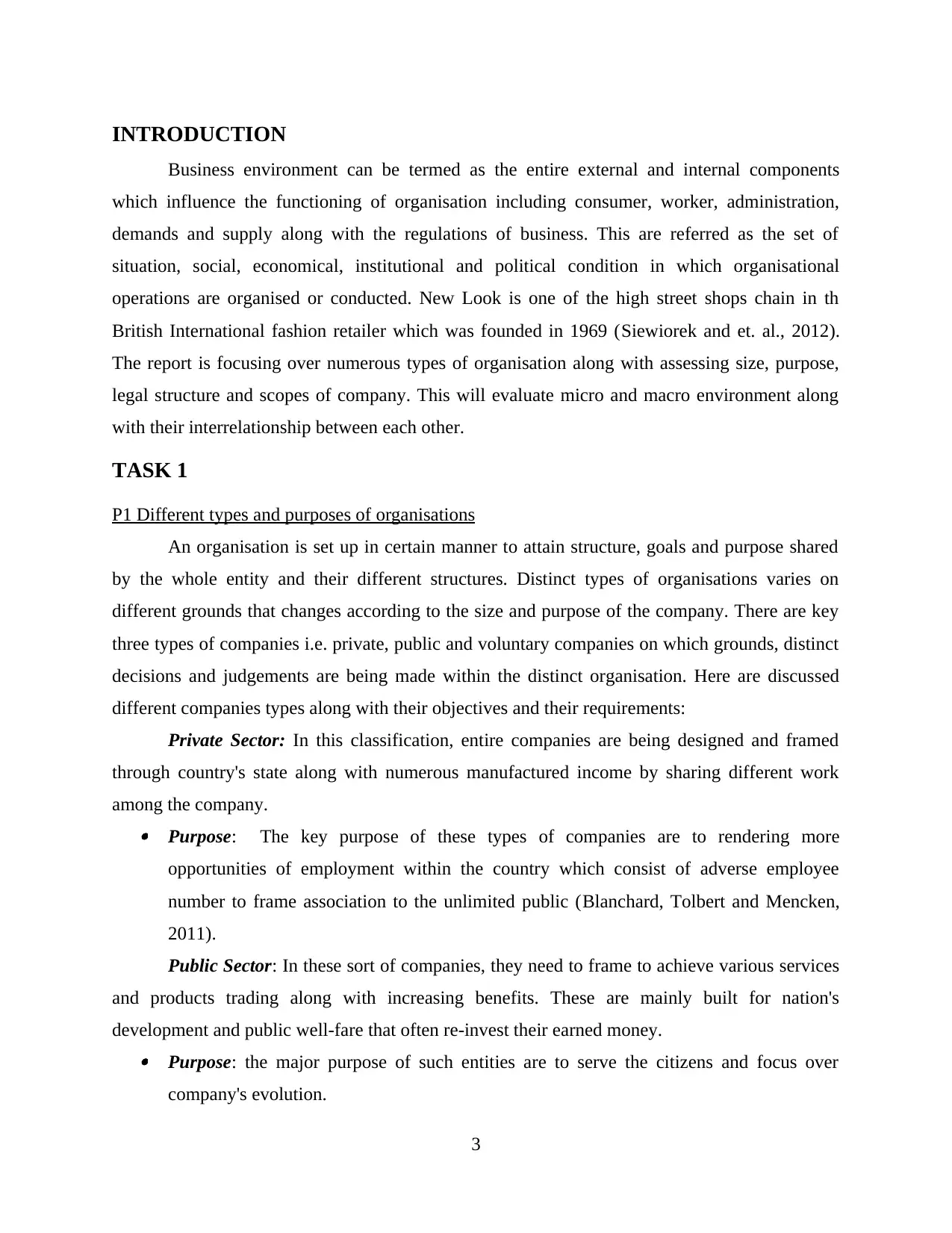
INTRODUCTION
Business environment can be termed as the entire external and internal components
which influence the functioning of organisation including consumer, worker, administration,
demands and supply along with the regulations of business. This are referred as the set of
situation, social, economical, institutional and political condition in which organisational
operations are organised or conducted. New Look is one of the high street shops chain in th
British International fashion retailer which was founded in 1969 (Siewiorek and et. al., 2012).
The report is focusing over numerous types of organisation along with assessing size, purpose,
legal structure and scopes of company. This will evaluate micro and macro environment along
with their interrelationship between each other.
TASK 1
P1 Different types and purposes of organisations
An organisation is set up in certain manner to attain structure, goals and purpose shared
by the whole entity and their different structures. Distinct types of organisations varies on
different grounds that changes according to the size and purpose of the company. There are key
three types of companies i.e. private, public and voluntary companies on which grounds, distinct
decisions and judgements are being made within the distinct organisation. Here are discussed
different companies types along with their objectives and their requirements:
Private Sector: In this classification, entire companies are being designed and framed
through country's state along with numerous manufactured income by sharing different work
among the company. Purpose: The key purpose of these types of companies are to rendering more
opportunities of employment within the country which consist of adverse employee
number to frame association to the unlimited public (Blanchard, Tolbert and Mencken,
2011).
Public Sector: In these sort of companies, they need to frame to achieve various services
and products trading along with increasing benefits. These are mainly built for nation's
development and public well-fare that often re-invest their earned money. Purpose: the major purpose of such entities are to serve the citizens and focus over
company's evolution.
3
Business environment can be termed as the entire external and internal components
which influence the functioning of organisation including consumer, worker, administration,
demands and supply along with the regulations of business. This are referred as the set of
situation, social, economical, institutional and political condition in which organisational
operations are organised or conducted. New Look is one of the high street shops chain in th
British International fashion retailer which was founded in 1969 (Siewiorek and et. al., 2012).
The report is focusing over numerous types of organisation along with assessing size, purpose,
legal structure and scopes of company. This will evaluate micro and macro environment along
with their interrelationship between each other.
TASK 1
P1 Different types and purposes of organisations
An organisation is set up in certain manner to attain structure, goals and purpose shared
by the whole entity and their different structures. Distinct types of organisations varies on
different grounds that changes according to the size and purpose of the company. There are key
three types of companies i.e. private, public and voluntary companies on which grounds, distinct
decisions and judgements are being made within the distinct organisation. Here are discussed
different companies types along with their objectives and their requirements:
Private Sector: In this classification, entire companies are being designed and framed
through country's state along with numerous manufactured income by sharing different work
among the company. Purpose: The key purpose of these types of companies are to rendering more
opportunities of employment within the country which consist of adverse employee
number to frame association to the unlimited public (Blanchard, Tolbert and Mencken,
2011).
Public Sector: In these sort of companies, they need to frame to achieve various services
and products trading along with increasing benefits. These are mainly built for nation's
development and public well-fare that often re-invest their earned money. Purpose: the major purpose of such entities are to serve the citizens and focus over
company's evolution.
3
⊘ This is a preview!⊘
Do you want full access?
Subscribe today to unlock all pages.

Trusted by 1+ million students worldwide
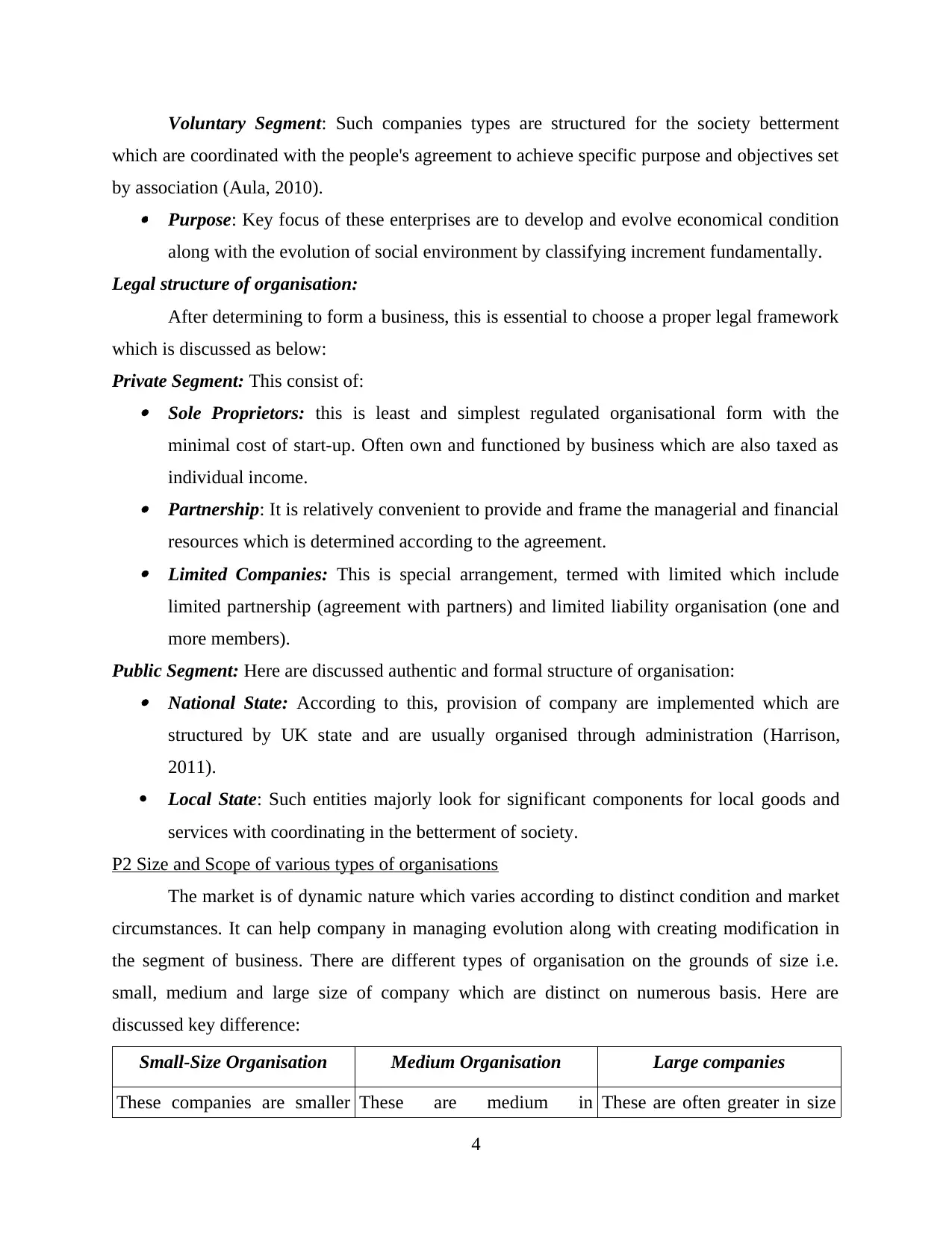
Voluntary Segment: Such companies types are structured for the society betterment
which are coordinated with the people's agreement to achieve specific purpose and objectives set
by association (Aula, 2010). Purpose: Key focus of these enterprises are to develop and evolve economical condition
along with the evolution of social environment by classifying increment fundamentally.
Legal structure of organisation:
After determining to form a business, this is essential to choose a proper legal framework
which is discussed as below:
Private Segment: This consist of: Sole Proprietors: this is least and simplest regulated organisational form with the
minimal cost of start-up. Often own and functioned by business which are also taxed as
individual income. Partnership: It is relatively convenient to provide and frame the managerial and financial
resources which is determined according to the agreement. Limited Companies: This is special arrangement, termed with limited which include
limited partnership (agreement with partners) and limited liability organisation (one and
more members).
Public Segment: Here are discussed authentic and formal structure of organisation: National State: According to this, provision of company are implemented which are
structured by UK state and are usually organised through administration (Harrison,
2011).
Local State: Such entities majorly look for significant components for local goods and
services with coordinating in the betterment of society.
P2 Size and Scope of various types of organisations
The market is of dynamic nature which varies according to distinct condition and market
circumstances. It can help company in managing evolution along with creating modification in
the segment of business. There are different types of organisation on the grounds of size i.e.
small, medium and large size of company which are distinct on numerous basis. Here are
discussed key difference:
Small-Size Organisation Medium Organisation Large companies
These companies are smaller These are medium in These are often greater in size
4
which are coordinated with the people's agreement to achieve specific purpose and objectives set
by association (Aula, 2010). Purpose: Key focus of these enterprises are to develop and evolve economical condition
along with the evolution of social environment by classifying increment fundamentally.
Legal structure of organisation:
After determining to form a business, this is essential to choose a proper legal framework
which is discussed as below:
Private Segment: This consist of: Sole Proprietors: this is least and simplest regulated organisational form with the
minimal cost of start-up. Often own and functioned by business which are also taxed as
individual income. Partnership: It is relatively convenient to provide and frame the managerial and financial
resources which is determined according to the agreement. Limited Companies: This is special arrangement, termed with limited which include
limited partnership (agreement with partners) and limited liability organisation (one and
more members).
Public Segment: Here are discussed authentic and formal structure of organisation: National State: According to this, provision of company are implemented which are
structured by UK state and are usually organised through administration (Harrison,
2011).
Local State: Such entities majorly look for significant components for local goods and
services with coordinating in the betterment of society.
P2 Size and Scope of various types of organisations
The market is of dynamic nature which varies according to distinct condition and market
circumstances. It can help company in managing evolution along with creating modification in
the segment of business. There are different types of organisation on the grounds of size i.e.
small, medium and large size of company which are distinct on numerous basis. Here are
discussed key difference:
Small-Size Organisation Medium Organisation Large companies
These companies are smaller These are medium in These are often greater in size
4
Paraphrase This Document
Need a fresh take? Get an instant paraphrase of this document with our AI Paraphraser
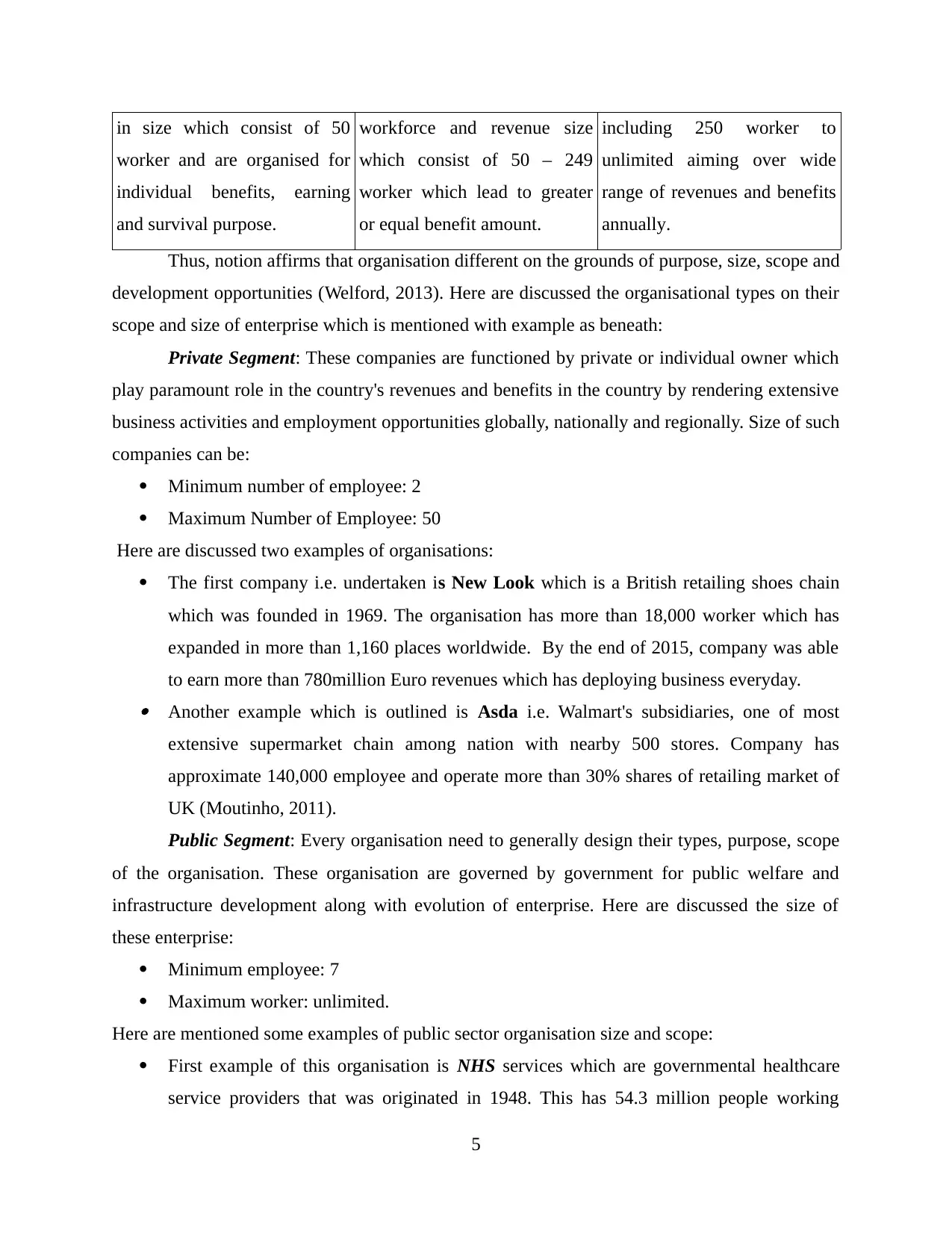
in size which consist of 50
worker and are organised for
individual benefits, earning
and survival purpose.
workforce and revenue size
which consist of 50 – 249
worker which lead to greater
or equal benefit amount.
including 250 worker to
unlimited aiming over wide
range of revenues and benefits
annually.
Thus, notion affirms that organisation different on the grounds of purpose, size, scope and
development opportunities (Welford, 2013). Here are discussed the organisational types on their
scope and size of enterprise which is mentioned with example as beneath:
Private Segment: These companies are functioned by private or individual owner which
play paramount role in the country's revenues and benefits in the country by rendering extensive
business activities and employment opportunities globally, nationally and regionally. Size of such
companies can be:
Minimum number of employee: 2
Maximum Number of Employee: 50
Here are discussed two examples of organisations:
The first company i.e. undertaken is New Look which is a British retailing shoes chain
which was founded in 1969. The organisation has more than 18,000 worker which has
expanded in more than 1,160 places worldwide. By the end of 2015, company was able
to earn more than 780million Euro revenues which has deploying business everyday. Another example which is outlined is Asda i.e. Walmart's subsidiaries, one of most
extensive supermarket chain among nation with nearby 500 stores. Company has
approximate 140,000 employee and operate more than 30% shares of retailing market of
UK (Moutinho, 2011).
Public Segment: Every organisation need to generally design their types, purpose, scope
of the organisation. These organisation are governed by government for public welfare and
infrastructure development along with evolution of enterprise. Here are discussed the size of
these enterprise:
Minimum employee: 7
Maximum worker: unlimited.
Here are mentioned some examples of public sector organisation size and scope:
First example of this organisation is NHS services which are governmental healthcare
service providers that was originated in 1948. This has 54.3 million people working
5
worker and are organised for
individual benefits, earning
and survival purpose.
workforce and revenue size
which consist of 50 – 249
worker which lead to greater
or equal benefit amount.
including 250 worker to
unlimited aiming over wide
range of revenues and benefits
annually.
Thus, notion affirms that organisation different on the grounds of purpose, size, scope and
development opportunities (Welford, 2013). Here are discussed the organisational types on their
scope and size of enterprise which is mentioned with example as beneath:
Private Segment: These companies are functioned by private or individual owner which
play paramount role in the country's revenues and benefits in the country by rendering extensive
business activities and employment opportunities globally, nationally and regionally. Size of such
companies can be:
Minimum number of employee: 2
Maximum Number of Employee: 50
Here are discussed two examples of organisations:
The first company i.e. undertaken is New Look which is a British retailing shoes chain
which was founded in 1969. The organisation has more than 18,000 worker which has
expanded in more than 1,160 places worldwide. By the end of 2015, company was able
to earn more than 780million Euro revenues which has deploying business everyday. Another example which is outlined is Asda i.e. Walmart's subsidiaries, one of most
extensive supermarket chain among nation with nearby 500 stores. Company has
approximate 140,000 employee and operate more than 30% shares of retailing market of
UK (Moutinho, 2011).
Public Segment: Every organisation need to generally design their types, purpose, scope
of the organisation. These organisation are governed by government for public welfare and
infrastructure development along with evolution of enterprise. Here are discussed the size of
these enterprise:
Minimum employee: 7
Maximum worker: unlimited.
Here are mentioned some examples of public sector organisation size and scope:
First example of this organisation is NHS services which are governmental healthcare
service providers that was originated in 1948. This has 54.3 million people working
5
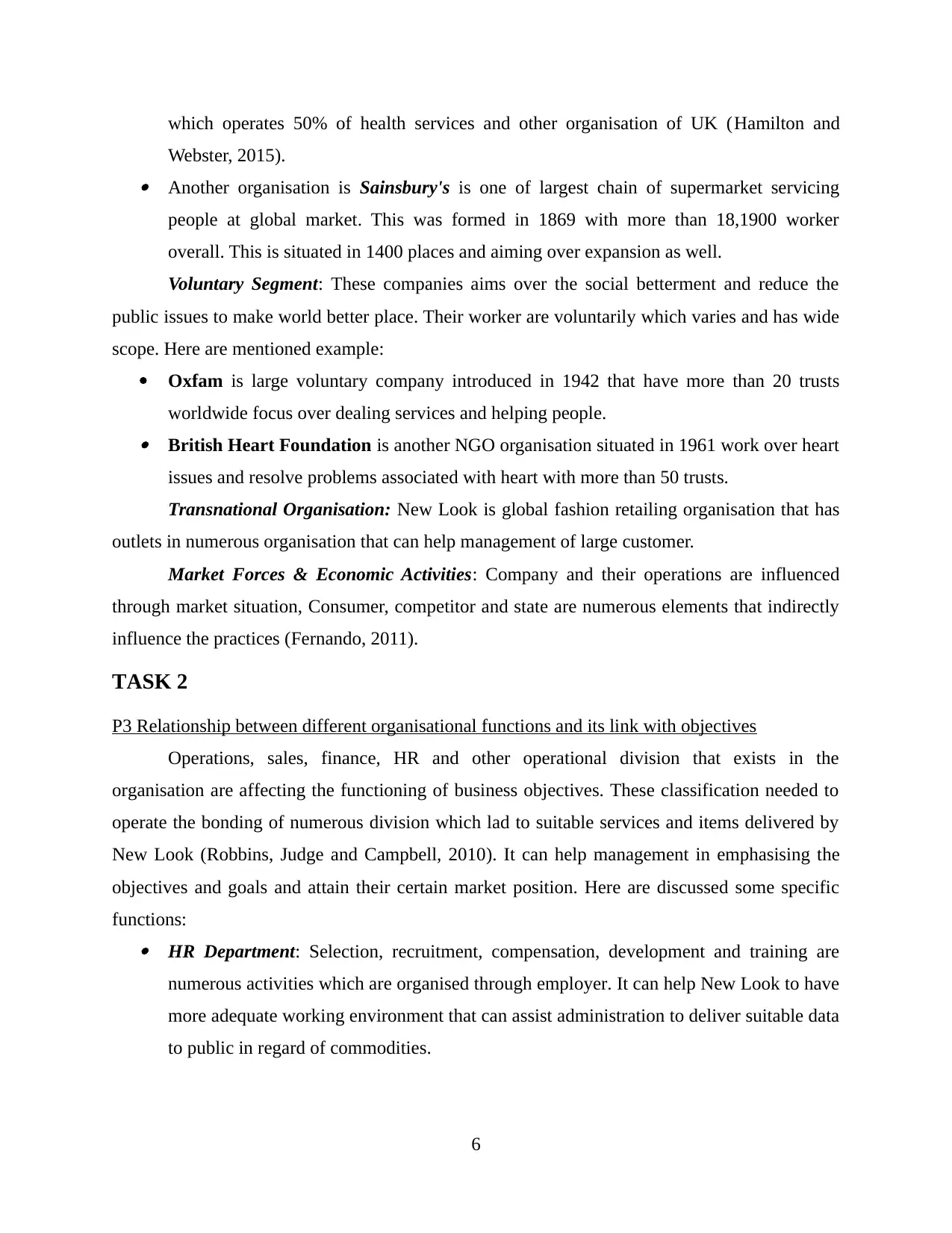
which operates 50% of health services and other organisation of UK (Hamilton and
Webster, 2015). Another organisation is Sainsbury's is one of largest chain of supermarket servicing
people at global market. This was formed in 1869 with more than 18,1900 worker
overall. This is situated in 1400 places and aiming over expansion as well.
Voluntary Segment: These companies aims over the social betterment and reduce the
public issues to make world better place. Their worker are voluntarily which varies and has wide
scope. Here are mentioned example:
Oxfam is large voluntary company introduced in 1942 that have more than 20 trusts
worldwide focus over dealing services and helping people. British Heart Foundation is another NGO organisation situated in 1961 work over heart
issues and resolve problems associated with heart with more than 50 trusts.
Transnational Organisation: New Look is global fashion retailing organisation that has
outlets in numerous organisation that can help management of large customer.
Market Forces & Economic Activities: Company and their operations are influenced
through market situation, Consumer, competitor and state are numerous elements that indirectly
influence the practices (Fernando, 2011).
TASK 2
P3 Relationship between different organisational functions and its link with objectives
Operations, sales, finance, HR and other operational division that exists in the
organisation are affecting the functioning of business objectives. These classification needed to
operate the bonding of numerous division which lad to suitable services and items delivered by
New Look (Robbins, Judge and Campbell, 2010). It can help management in emphasising the
objectives and goals and attain their certain market position. Here are discussed some specific
functions: HR Department: Selection, recruitment, compensation, development and training are
numerous activities which are organised through employer. It can help New Look to have
more adequate working environment that can assist administration to deliver suitable data
to public in regard of commodities.
6
Webster, 2015). Another organisation is Sainsbury's is one of largest chain of supermarket servicing
people at global market. This was formed in 1869 with more than 18,1900 worker
overall. This is situated in 1400 places and aiming over expansion as well.
Voluntary Segment: These companies aims over the social betterment and reduce the
public issues to make world better place. Their worker are voluntarily which varies and has wide
scope. Here are mentioned example:
Oxfam is large voluntary company introduced in 1942 that have more than 20 trusts
worldwide focus over dealing services and helping people. British Heart Foundation is another NGO organisation situated in 1961 work over heart
issues and resolve problems associated with heart with more than 50 trusts.
Transnational Organisation: New Look is global fashion retailing organisation that has
outlets in numerous organisation that can help management of large customer.
Market Forces & Economic Activities: Company and their operations are influenced
through market situation, Consumer, competitor and state are numerous elements that indirectly
influence the practices (Fernando, 2011).
TASK 2
P3 Relationship between different organisational functions and its link with objectives
Operations, sales, finance, HR and other operational division that exists in the
organisation are affecting the functioning of business objectives. These classification needed to
operate the bonding of numerous division which lad to suitable services and items delivered by
New Look (Robbins, Judge and Campbell, 2010). It can help management in emphasising the
objectives and goals and attain their certain market position. Here are discussed some specific
functions: HR Department: Selection, recruitment, compensation, development and training are
numerous activities which are organised through employer. It can help New Look to have
more adequate working environment that can assist administration to deliver suitable data
to public in regard of commodities.
6
⊘ This is a preview!⊘
Do you want full access?
Subscribe today to unlock all pages.

Trusted by 1+ million students worldwide
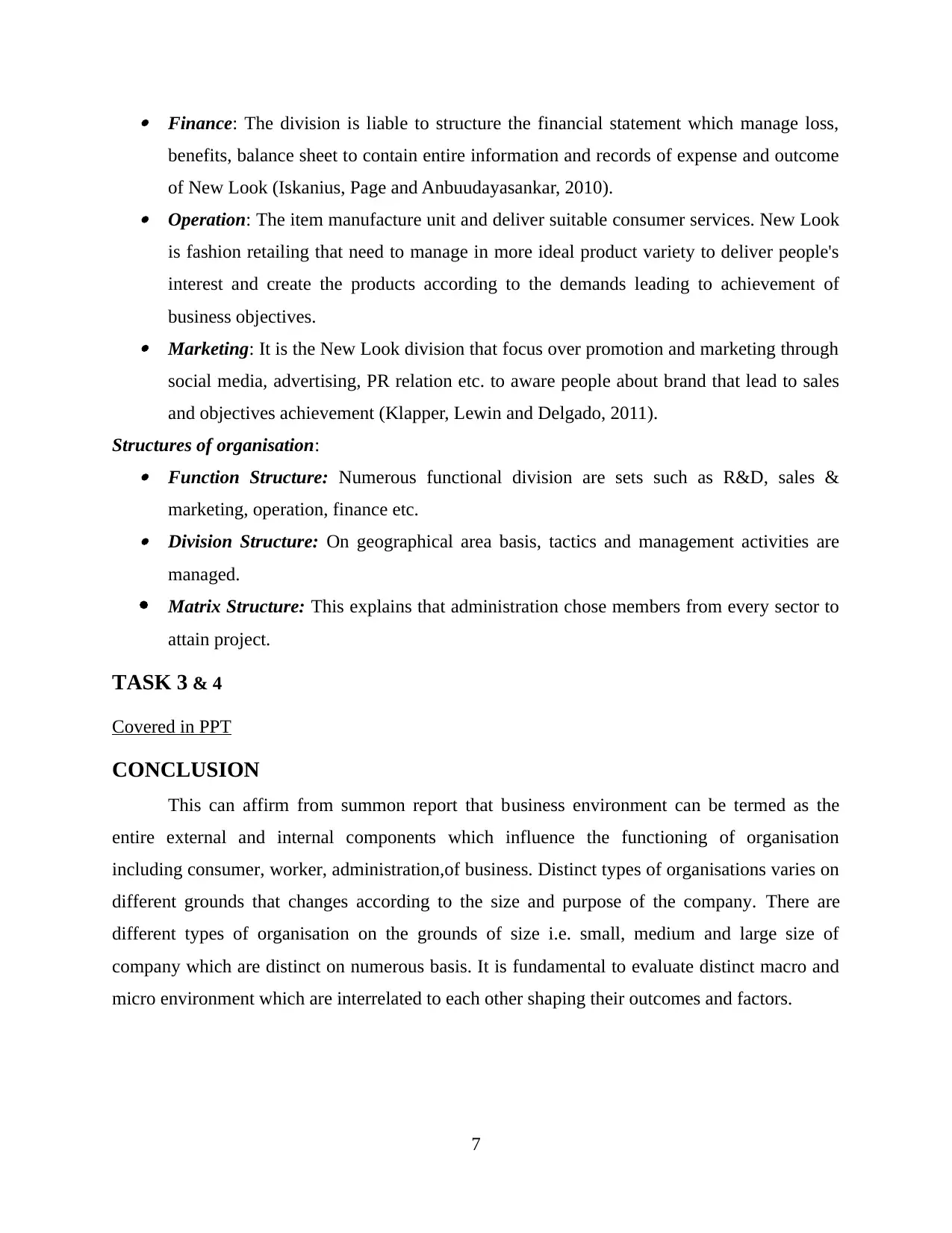
Finance: The division is liable to structure the financial statement which manage loss,
benefits, balance sheet to contain entire information and records of expense and outcome
of New Look (Iskanius, Page and Anbuudayasankar, 2010). Operation: The item manufacture unit and deliver suitable consumer services. New Look
is fashion retailing that need to manage in more ideal product variety to deliver people's
interest and create the products according to the demands leading to achievement of
business objectives. Marketing: It is the New Look division that focus over promotion and marketing through
social media, advertising, PR relation etc. to aware people about brand that lead to sales
and objectives achievement (Klapper, Lewin and Delgado, 2011).
Structures of organisation: Function Structure: Numerous functional division are sets such as R&D, sales &
marketing, operation, finance etc. Division Structure: On geographical area basis, tactics and management activities are
managed.
Matrix Structure: This explains that administration chose members from every sector to
attain project.
TASK 3 & 4
Covered in PPT
CONCLUSION
This can affirm from summon report that business environment can be termed as the
entire external and internal components which influence the functioning of organisation
including consumer, worker, administration,of business. Distinct types of organisations varies on
different grounds that changes according to the size and purpose of the company. There are
different types of organisation on the grounds of size i.e. small, medium and large size of
company which are distinct on numerous basis. It is fundamental to evaluate distinct macro and
micro environment which are interrelated to each other shaping their outcomes and factors.
7
benefits, balance sheet to contain entire information and records of expense and outcome
of New Look (Iskanius, Page and Anbuudayasankar, 2010). Operation: The item manufacture unit and deliver suitable consumer services. New Look
is fashion retailing that need to manage in more ideal product variety to deliver people's
interest and create the products according to the demands leading to achievement of
business objectives. Marketing: It is the New Look division that focus over promotion and marketing through
social media, advertising, PR relation etc. to aware people about brand that lead to sales
and objectives achievement (Klapper, Lewin and Delgado, 2011).
Structures of organisation: Function Structure: Numerous functional division are sets such as R&D, sales &
marketing, operation, finance etc. Division Structure: On geographical area basis, tactics and management activities are
managed.
Matrix Structure: This explains that administration chose members from every sector to
attain project.
TASK 3 & 4
Covered in PPT
CONCLUSION
This can affirm from summon report that business environment can be termed as the
entire external and internal components which influence the functioning of organisation
including consumer, worker, administration,of business. Distinct types of organisations varies on
different grounds that changes according to the size and purpose of the company. There are
different types of organisation on the grounds of size i.e. small, medium and large size of
company which are distinct on numerous basis. It is fundamental to evaluate distinct macro and
micro environment which are interrelated to each other shaping their outcomes and factors.
7
Paraphrase This Document
Need a fresh take? Get an instant paraphrase of this document with our AI Paraphraser
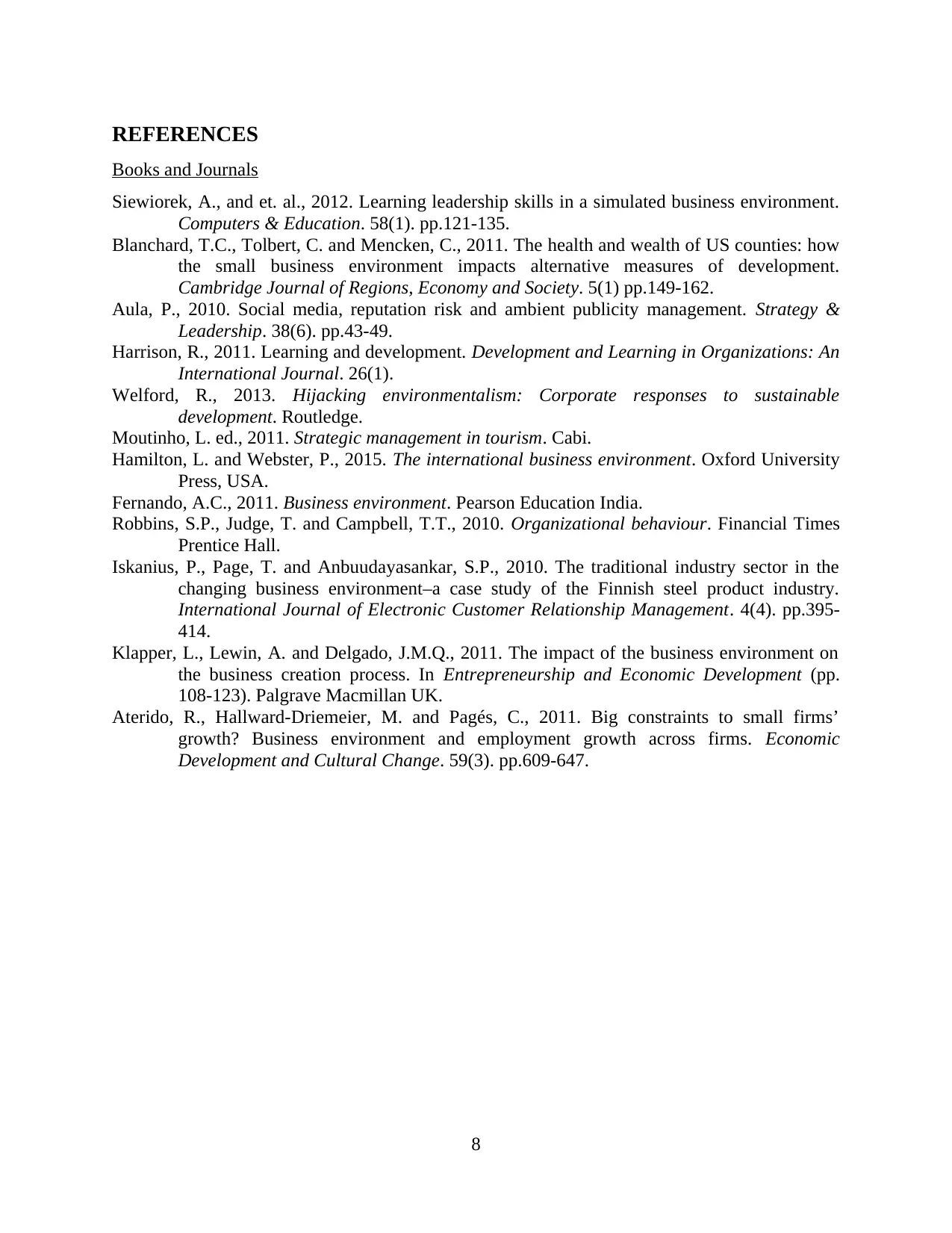
REFERENCES
Books and Journals
Siewiorek, A., and et. al., 2012. Learning leadership skills in a simulated business environment.
Computers & Education. 58(1). pp.121-135.
Blanchard, T.C., Tolbert, C. and Mencken, C., 2011. The health and wealth of US counties: how
the small business environment impacts alternative measures of development.
Cambridge Journal of Regions, Economy and Society. 5(1) pp.149-162.
Aula, P., 2010. Social media, reputation risk and ambient publicity management. Strategy &
Leadership. 38(6). pp.43-49.
Harrison, R., 2011. Learning and development. Development and Learning in Organizations: An
International Journal. 26(1).
Welford, R., 2013. Hijacking environmentalism: Corporate responses to sustainable
development. Routledge.
Moutinho, L. ed., 2011. Strategic management in tourism. Cabi.
Hamilton, L. and Webster, P., 2015. The international business environment. Oxford University
Press, USA.
Fernando, A.C., 2011. Business environment. Pearson Education India.
Robbins, S.P., Judge, T. and Campbell, T.T., 2010. Organizational behaviour. Financial Times
Prentice Hall.
Iskanius, P., Page, T. and Anbuudayasankar, S.P., 2010. The traditional industry sector in the
changing business environment–a case study of the Finnish steel product industry.
International Journal of Electronic Customer Relationship Management. 4(4). pp.395-
414.
Klapper, L., Lewin, A. and Delgado, J.M.Q., 2011. The impact of the business environment on
the business creation process. In Entrepreneurship and Economic Development (pp.
108-123). Palgrave Macmillan UK.
Aterido, R., Hallward-Driemeier, M. and Pagés, C., 2011. Big constraints to small firms’
growth? Business environment and employment growth across firms. Economic
Development and Cultural Change. 59(3). pp.609-647.
8
Books and Journals
Siewiorek, A., and et. al., 2012. Learning leadership skills in a simulated business environment.
Computers & Education. 58(1). pp.121-135.
Blanchard, T.C., Tolbert, C. and Mencken, C., 2011. The health and wealth of US counties: how
the small business environment impacts alternative measures of development.
Cambridge Journal of Regions, Economy and Society. 5(1) pp.149-162.
Aula, P., 2010. Social media, reputation risk and ambient publicity management. Strategy &
Leadership. 38(6). pp.43-49.
Harrison, R., 2011. Learning and development. Development and Learning in Organizations: An
International Journal. 26(1).
Welford, R., 2013. Hijacking environmentalism: Corporate responses to sustainable
development. Routledge.
Moutinho, L. ed., 2011. Strategic management in tourism. Cabi.
Hamilton, L. and Webster, P., 2015. The international business environment. Oxford University
Press, USA.
Fernando, A.C., 2011. Business environment. Pearson Education India.
Robbins, S.P., Judge, T. and Campbell, T.T., 2010. Organizational behaviour. Financial Times
Prentice Hall.
Iskanius, P., Page, T. and Anbuudayasankar, S.P., 2010. The traditional industry sector in the
changing business environment–a case study of the Finnish steel product industry.
International Journal of Electronic Customer Relationship Management. 4(4). pp.395-
414.
Klapper, L., Lewin, A. and Delgado, J.M.Q., 2011. The impact of the business environment on
the business creation process. In Entrepreneurship and Economic Development (pp.
108-123). Palgrave Macmillan UK.
Aterido, R., Hallward-Driemeier, M. and Pagés, C., 2011. Big constraints to small firms’
growth? Business environment and employment growth across firms. Economic
Development and Cultural Change. 59(3). pp.609-647.
8
1 out of 8
Related Documents
Your All-in-One AI-Powered Toolkit for Academic Success.
+13062052269
info@desklib.com
Available 24*7 on WhatsApp / Email
![[object Object]](/_next/static/media/star-bottom.7253800d.svg)
Unlock your academic potential
Copyright © 2020–2025 A2Z Services. All Rights Reserved. Developed and managed by ZUCOL.





